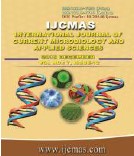


 National Academy of Agricultural Sciences (NAAS)
National Academy of Agricultural Sciences (NAAS)

|
PRINT ISSN : 2319-7692
Online ISSN : 2319-7706 Issues : 12 per year Publisher : Excellent Publishers Email : editorijcmas@gmail.com / submit@ijcmas.com Editor-in-chief: Dr.M.Prakash Index Copernicus ICV 2018: 95.39 NAAS RATING 2020: 5.38 |
The country is the largest producer of oilseeds in the world and oilseed sector occupies an important position in the agricultural industry as well as in trade and national economy of the country. Oilseeds are among the major crops that are grown in the country apart from cereals. Linseed is an important industrial and edible oil and fiber producing crop. It also being as medicinal plant is rich in oil (41%), protein (20%), dietary fiber (28%), contains 7.7% moisture and 3.3% ashes. It has a high percentage of essential fatty acids, 75% polyunsaturated fatty acids, 57% alphalinolenic acid, which is an omega-3 fatty acid, and 16% linoleic acid, which is an omega-6 fatty acid (Morris, 2005). In terms of acreage, production and economic value, these crops are second only to food grains. India is the fifth largest vegetable oil economy in the world next only to USA, China, Brazil and Argentina, and has an annual turnover of about ` 80000 crore. India accounts for 12-15 per cent of global oilseeds area, 7-8 per cent of oilseeds production, 6-7 per cent of vegetable oils production, 9-12 per cent of vegetable oils import and 9-10 per cent of the edible oils consumption (Jha et al., 2012). Linseed is an important industrial and edible oil and fiber producing crop. It also being as medicinal plant is rich in oil (41%), protein (20%), dietary fiber (28%), contains 7.7% moisture and 3.3% ashes. It has a high percentage of essential fatty acids, 75% polyunsaturated fatty acids, 57% alphalinolenic acid, which is an omega-3 fatty acid, and 16% linoleic acid, which is an omega-6 fatty acid (Morris, 2005). Flaxseed or linseed (Linum usitatissimum L.) comes from the flax plant, an annual herb. The main importance of flaxseed is in the human nutrition sector because it is emerging as an important functional food ingredient thanks to the content of active compounds, pointed to provide health benefits.
 |
 |
 |
 |
 |